Introduction
Carrots (Daucus carota) are an important vegetable crop grown in the United States (US) and around the world. Globally, the US is ranked third in the production volume of carrots, following China and Uzbekistan, with an average production of 1.9 million tons per year. In the last three decades, an increasing trend has been observed in carrot production in the US, with total production exceeding 680 million dollars per year from 2010 to 2020 (Figure 1). California produced 85% of the carrots grown in the US, followed by Michigan and Texas (USDA-NASS 2020). However, with water shortages in California and increased shipping costs to the large eastern US markets, carrot acreage has moved to southeastern states. The regions of southern Georgia and northern Florida have become areas of particular interest in expanding US carrot production, with their mild winters, deep sandy soils, easy access to eastern markets, and the accessibility to water stored in the underground Floridan aquifer.
Although north Florida’s deep sandy soils provide optimal conditions for carrot production, these soils are also very vulnerable to nutrient losses, particularly nitrate leaching. Therefore, from emergence to harvest, effective nutrient management is important at each critical carrot growth stage. Nitrogen (N) use in carrots can vary substantially depending on cultivars, growth stage, canopy and leaf structure, population density, soil type, climate conditions, and other soil and crop management practices. Yet, detailed information on carrot N management in deep sandy soils in Florida, which is required for optimizing production while reducing environmental impacts, is lacking. Additionally, N use for carrots has not been developed for modern cultivars in the climate, soil, and management conditions of Florida. As western producers move east, the potential of increased carrot production in this region emphasizes the importance of creating up-to-date carrot production recommendations that align with optimum economic and sustainable growing practices.
This Extension publication discusses carrot growth characteristics and provides N fertilizer best management practices (BMPs) for carrot crops growing in north Florida. The N management guidelines presented in this publication are based on multiyear field-based research conducted by UF/IFAS. This publication’s target audience is carrot growers, Extension agents, crop consultants, representatives of the fertilizer industry, state and local agencies, students, instructors, researchers, and interested Florida community members.
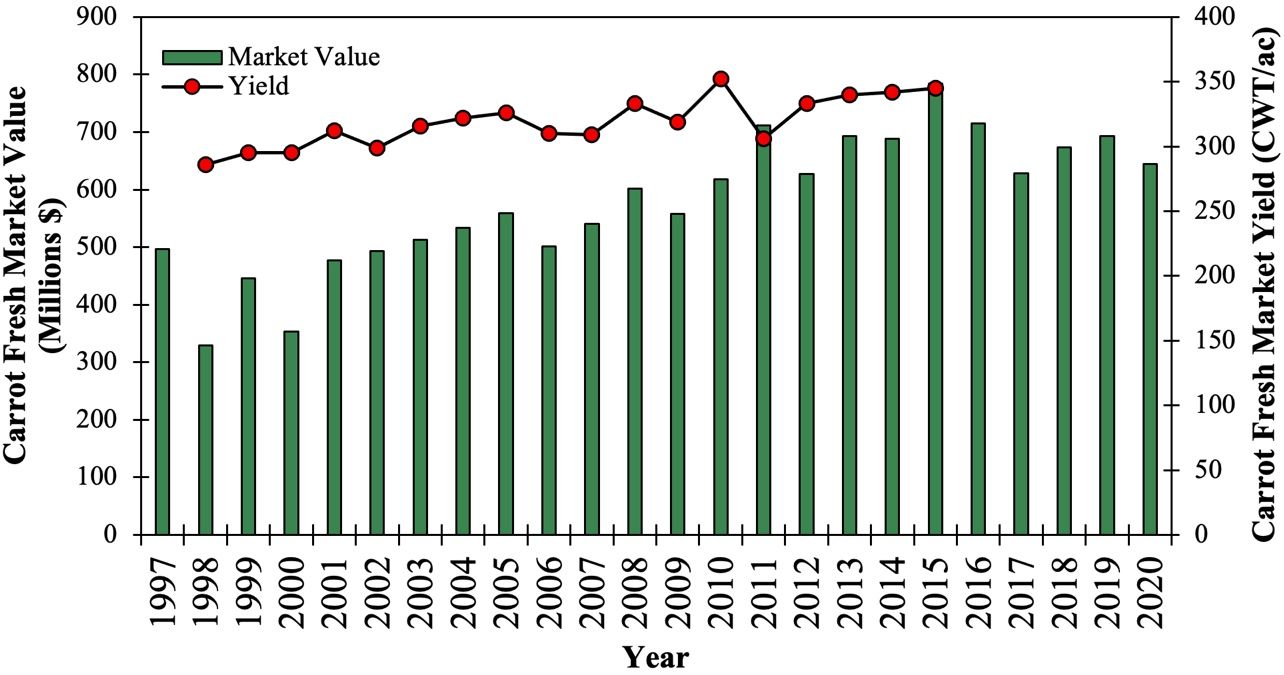
Credit: Morgan Morrow and Vivek Sharma, UF/IFAS
Carrot Growth Characteristics
Carrots are a cool-season crop with optimum growth and root color when the air temperatures are 61oF–75oF (16oC–24oC). This makes September through November the ideal time for seeding carrots in north Florida. In general, with the exception of muck soils where carrots were historically grown in Florida, carrots grow best in well-drained sandy soils, with soil pH ranging between 6.0 and 7.8 (Praciak 2022; Beuzelin et al. 2021; Rubatzky et al. 1999). However, carrots can be grown in other soil types as long as the soils are uniform with no restrictive layers in the upper 30 inches of the soil profile for root growth.
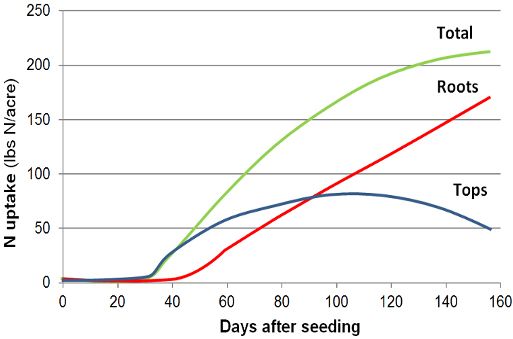
Credit: California Department of Food and Agriculture
The N needs of the carrot crop are complex and, as with any crop, change throughout the various growth stages during the growing season. The N needs depend on a variety of factors including cultivars, seeding rate, growth stage, climate condition, irrigation, and other crop management practices. Figure 2 shows the growing season progression of N uptake in carrots’ roots and tops. In general, N uptake is very low in the early stages of development, but it increases steadily as the plant undergoes rapid growth (CDFA 2022a; Simon et al. 2008). The carrot growth stages are important to understand because they give us a deeper idea of N needs for the crop throughout the growing season. Figures 3 and 4 visually represent the carrot growth stages. The next section elaborates upon these growth stages, carrot production practices, and the way these factors affect N management.

Credit: Morgan Morrow and Vivek Sharma, UF/IFAS
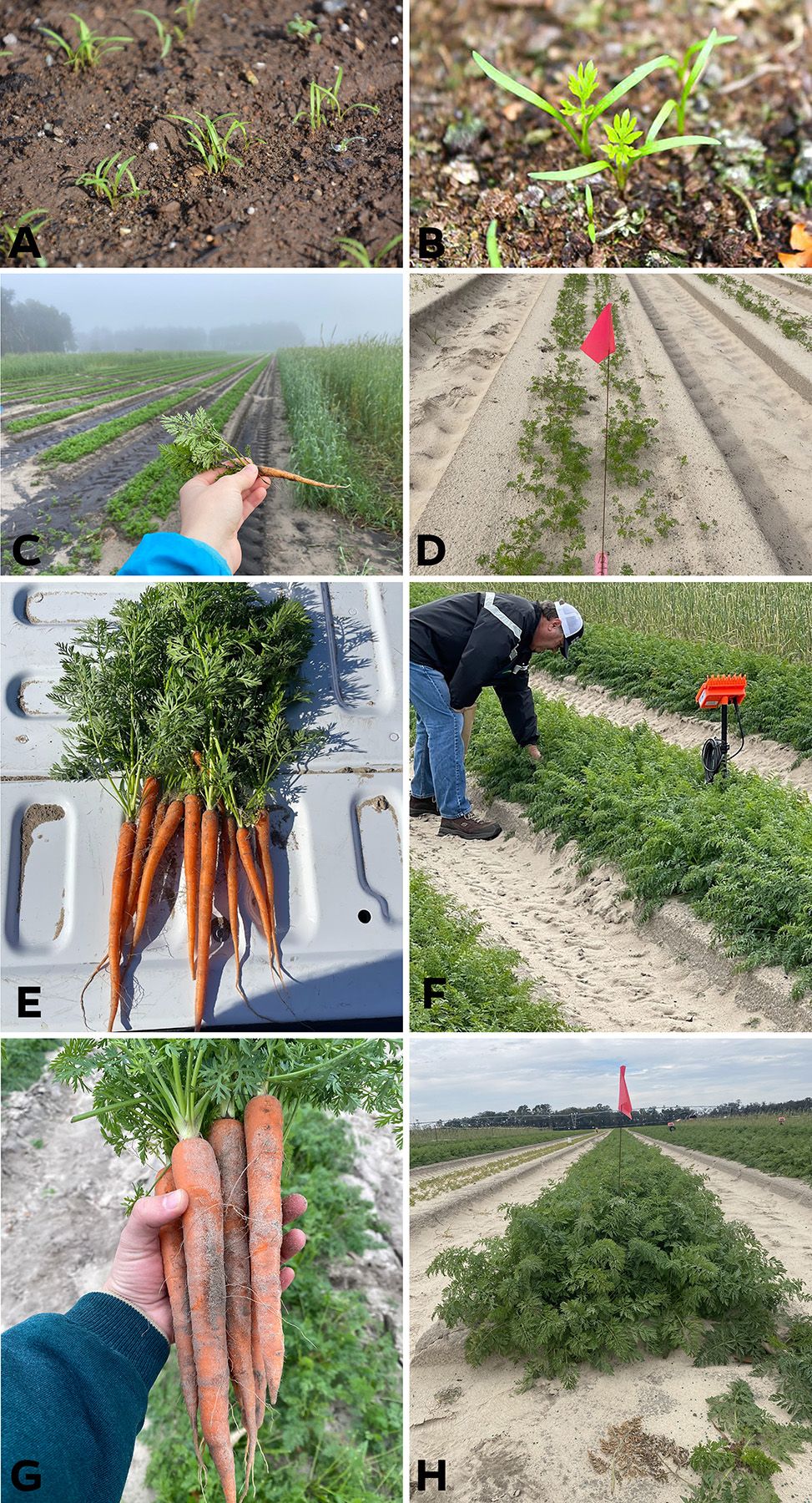
Credit: (A) Courtesy of garden.eco. (B) Courtesy of mytinyplot.com. (C–H) Vivek Sharma, Robert Hochmuth, and Morgan Morrow, UF/IFAS
Growth Stage I: Germination
The first carrot growth stage includes planting and germination. Seeds are generally sown at shallow depths of 3–5 mm and in raised beds, often at high densities for fresh market whole carrots (350,000 seeds/ac–450,000 seeds/ac). Seedlings at the soil surface will first appear about 9–13 days after sowing depending on the air and soil temperature (Figure 3 and Figure 4a). In general, N uptake during this growth stage is low. However, availability of some N at planting is critical for the initial plant development. In Florida conditions, approximately 25 lb N/ac–30 lb N/ac at planting is appropriate for initial growth. It is important to avoid excessive available N application at planting because it can result in root-forking and reduced stands and risk leaching by rainfall or excessive irrigation.
Growth Stage II: True Leaf Growth
The second growth stage is the formation of the first true leaf. Figure 3 and Figure 4b represent the difference in leaf shape between the first true leaf and cotyledon leaves. The first true leaf appears between 3 and 4 weeks after sowing. After the first true leaf, the next three true leaves will appear at 4- to 5-day intervals. The rest of the leaves appear gradually, with 15–18 days between subsequent leaves (Praciak 2022). The N uptake during this stage is generally low.
Growth Stage III: Early Storage Root Growth
Early root growth is one of the most important stages, where the storage root begins to lengthen and expand. The storage root is what we all know and love as a delicious vegetable: the carrot. In general, the storage root begins to form approximately 25 to 30 days after sowing. Swelling and enlargement of the storage root occur on the upper half of the taproot approximately 30 to 40 days after germination. Nitrogen uptake during the period before the root expansion and thickening is typically less than 30 lb N/ac (CDFA 2022b).
Growth Stage IV: Rapid Leaf and Root Growth
During this stage of the fresh market carrot’s growth, the storage root and canopy cover continue to expand until the harvest stage. Storage root growth during this stage is quite rapid, and N uptake increases steadily (Rubatzky et al. 1999; CDFA 2022a). Nitrogen uptake is low initially but increases steadily as the foliage length increases. Uptake reaches a steady state about 60–70 days after sowing when maximum leaf length is achieved. A decline in leaf N content can be observed later in the growing season due to leaf abscission or redistribution of N to the storage roots (Westerveld et al. 2006). During this stage, storage root development begins to increase steadily until harvest. Soil compaction during this stage can restrict the root length and alter root shape. North Florida’s deep sandy soils especially favor carrot production during this stage. In general, warm days and cool night temperatures provide the best combination of root length and diameter. Air temperature between 68oF and 75oF (20oC–24oC) favors an increase in early storage root length. Insufficient or excessive soil moisture and nutrient availability during this stage can hinder storage root growth. For example, low moisture during this stage results in the root surface becoming dimpled and corrugated, whereas excessive moisture results in cork-like outgrowth at lateral root bases and hairy root surface (Rubatzky et al. 1999). For detailed information on carrot water use, consult Ask IFAS publication SL 278, “Crop Water Use and Irrigation Scheduling Guide for North Florida” (Sharma et al. 2020).
Growth Stage V: Maturity
Although root enlargement will continue until harvest, the rate of growth slows as the crop starts to get closer to its maturity stage. Carrots are unique in that they do not have a defined maturity stage in their plant growth cycle, but carrots tend to lose flavor and texture if allowed to grow to their truly mature size (Rubatzky et al. 1999). Therefore, harvesting of carrots depends largely on “cultivar, intended market use, [and] market conditions.” Days until harvest after planting for normal-sized carrots in Florida can range anywhere from 120 to 150 days or more, with longer growing seasons generally seen with cool-season cultivars (Simon et al. 2008). For visual reference of carrot harvesting and production in north Florida, refer to “UF/IFAS New Product: North Florida Carrots.”
Additional Growth Stages
Carrots can be biennial if seeds are the desired end goal of production because leaving the crop for two growing seasons allows the plants to flower and produce seeds. Fresh market carrot production does not focus on the biennial potential of the carrot crop because the focus is on harvesting the root in its vegetative stage, which is before the flowering stage. For more information about the flowering stage and vernalization requirements of carrot crops, refer to the resources listed in the publications by Rubatzky et al. (1999) and Praciak (2022).
Importance of Nitrogen Fertilizer Management in Florida for Carrots—Case Study: Impact of Nitrogen Rate on Yield and Quality of Four Carrot Cultivars
The deep sandy soils that make up the agricultural region of the Suwannee River Basin are excellent for growing many vegetables and row crops such as carrots. However, these soils are highly vulnerable to nutrient leaching, especially N. Accumulation of N from runoff, erosion, and leaching has led it to be identified as an “impairment to the water bodies” in the Suwannee River Basin area. The Suwannee River Basin Management Action Plan (BMAP) proposed in 2018 currently guides the way to restoring and protecting the water quality of these important water bodies, with agricultural producers being a large part of that effort (FDEP 2018). At the same time, N is usually the most limiting nutrient in sandy soils. Previous studies conducted in the 1990s have reported 175 lb of N/ac as the recommended N rate for carrots (Liu et al. 2021; Hochmuth et al. 1999). However, with newer cultivars, increased seeding rate, different bed and row configuration, and refined irrigation and fertilizer management practices, it is important to update these potentially outdated recommendations.
Field trials were conducted at the UF/IFAS North Florida Research and Education Center—Suwannee Valley in Live Oak, FL for two consecutive carrot growing seasons (2016–2017 and 2017–2018).The objective was to update the N recommendations for carrots based on a specific set of N management practices and to provide information on the effect of N rate on four carrot cultivars grown in north Florida (Hochmuth et al. 2021). Two whole carrot fresh market cultivars (Choctaw and Maverick) and two cut-and-peel market carrot cultivars (Triton and Uppercut 25) were investigated in this study. Eight different conventional N fertilizer application rates of 50 lb N/ac, 100 lb N/ac, 150 lb N/ac, 200 lb N/ac, 250 lb N/ac, 300 lb N/ac, 350 lb N/ac, and 400 lb N/ac were selected for the study. For additional specifics regarding project management practices and planting parameters, refer to Hochmuth et al. (2021).
Effects of the eight N fertilizer rates were analyzed based on plant performance parameters during the growing season and yield and quality characteristics of harvested crops. Plant performance parameters investigated in the study included leaf tissue %N content and plant height. Quality characteristics included individual carrot weight, diameter of the top of the carrot root, and length of 15 randomly selected carrots from each plot. Carrots were harvested based on local grower recommendations and analysis of preharvest samplings of treatments to determine if carrots were at marketable lengths and widths.
For both years, the leaf N content increased with increasing fertilization rate. Newly released recommendations for average leaf N content for carrots grown in Florida at our specified sampling dates’ growth stages are 2.85%–3.5% (Hochmuth et al. 2022). In this study, the leaf N content for all the N fertilization rates was within or above these recommended percentages, which varied from 3%–3.9% (Figure 5). Although cold injury to the leaves could possibly stunt crops from taking up N, the crops were not noticeably impacted in this study. Both growing seasons were relatively dry with minimal N leaching rainfall events, so most of the applied N was available for plant uptake. However, in a wetter growing season, leaching rain events can reduce the N availability and uptake by the plants. Therefore, it is critical to avoid N application events before large rainfall events. This N management strategy will help maximize uptake potential and minimize leaching potential.

Credit: Vivek Sharma and Morgan Morrow, UF/IFAS
Figure 6 represents the average carrot marketable yield from the 2016 and 2017 growing seasons for the eight N treatments and four cultivars investigated in this study. On average, the “cut-and-peel” cultivar Triton yielded the highest, followed by Uppercut 25, Maverick, and Choctaw. However, it is important to note that all cultivars across both the 2016 and 2017 seasons yielded harvests within or above the north Florida industry-expected yields of 25 tons/acre to 30 tons/acre.
The difference in yield among cultivars might be due to differences in the carrot quality characteristics. For example, as per the USDA quality standards, carrots sold in the US must have a diameter greater than 0.75 inch and less than 1.5 inches and a length greater than 5 inches. In this study, whole carrot cultivars achieved the marketable diameter across all N treatments over both growing seasons. However, both cut-and-peel cultivars did not meet the marketable diameter for lower N rates of 50 lb N/ac. As for the length, all cultivars were able to achieve the USDA’s standard of 5 inches, except when the Choctaw, Triton, and Uppercut 25 cultivars were fertilized at the lowest N rate of 50 lb N/ac.
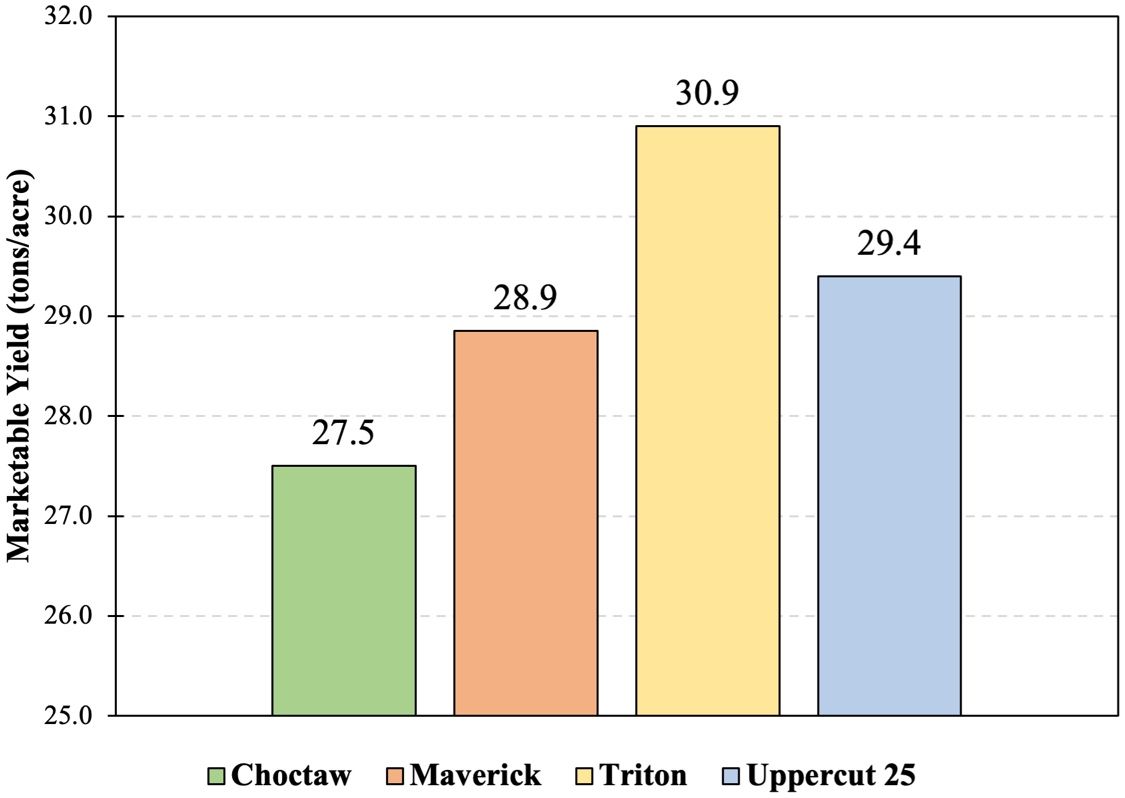
Credit: Morgan Morrow and Vivek Sharma, UF/IFAS
For both growing seasons, the carrot marketable yield had a significant positive response with increasing N fertilization as described by the quadratic plateau curve, where carrot yield starts to level off after N rates of 184 lb N/ac (Figure 7). For example, in both years, carrots fertilized with 150 lb N/ac or more yielded 31.5 tons/ac to 32.5 tons/ac of carrots, with additional N providing no further yield increases. Peak optimal economic yield could be obtained at 184 lb N/ac with a predicted yield of 31.8 tons/ac (Hochmuth et al. 2021). Note that this 184 lb N/ac level is only valid with similar growing season conditions and management practices adopted in this study. Based on this published research using the best management practices available at the time, UF/IFAS increased the N recommendation from 175 lb/ac to 200 lb/ac in 2022. The 200 lb/ac rate is approved by the UF/IFAS Plant Nutrient Oversight Committee (PNOC) and pending publication. This rate may not be sufficient for years with high leaching rainfall events and implementation of differing production management practices from the study. For example, in this study, all the fertilizer was applied at the top of the bed using the drop spreader in weekly applications (Figure 8).
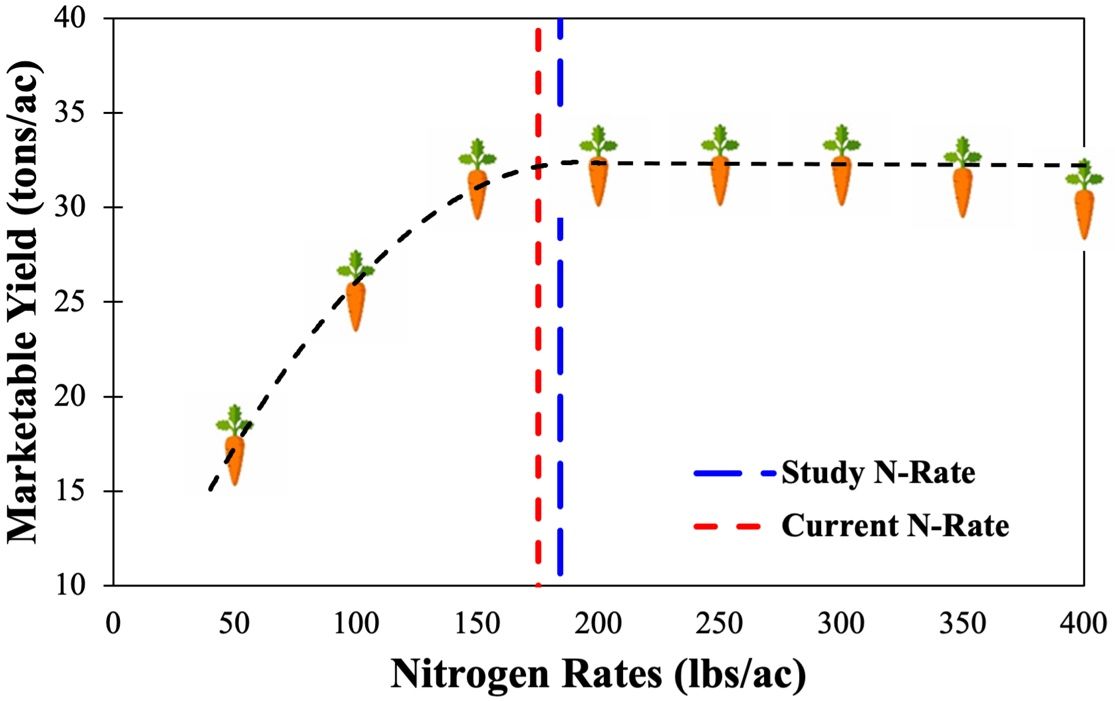
Credit: Vivek Sharma, Morgan Morrow, and Bob Hochmuth, UF/IFAS

Credit: Vivek Sharma, Morgan Morrow, and Bob Hochmuth, UF/IFAS
Summary and Key Takeaways
With optimal growing conditions, eager producers, and close proximity to large markets, north Florida sits uniquely positioned to become the carrot-producing hub of the East Coast. Although this unknown territory is exciting for Florida’s agricultural industry and economy, caution is necessary, as unaddressed, outdated, and missing management guidelines could lead to negative environmental impacts. Sandy soils in much of this region drain into unconfined parts of the Floridan aquifer. Therefore, it is important to provide tools to help reduce nutrient leaching in order to protect Florida’s ecotourism, drinking water, and agricultural resources. Research experiments discussed in this publication are essential to the development of crucial management guidelines that help to improve the social, economic, and environmental impact of this agricultural industry. Continued research, education, and Extension outreach of these ongoing trials are fundamental building blocks in supporting the sustainable creation and expansion of this potential new market.
References
Beuzelin, J., P. J. Dittmar, R. N. Raid, H. A. Smith, B. Wells, J. Desaeger, L. Zotarelli, S. Zhang, Q. Wang, and C. Frey. 2021. “Chapter 15. Root Crop Production in Florida: HS965/CV300, rev. 4/2021.” EDIS 2021 (VPH). https://doi.org/10.32473/edis-cv300-2021
California Department of Food and Agriculture, Fertilizer Research and Education Program, and UC Davis. 2022a. California Crop Fertilization Guidelines: Carrot Nitrogen Uptake and Partitioning. https://www.cdfa.ca.gov/is/ffldrs/frep/FertilizationGuidelines/N_Carrot.html#References
California Department of Food and Agriculture, Fertilizer Research and Education Program, and UC Davis. 2022b. California Crop Fertilization Guidelines: Carrots. https://www.cdfa.ca.gov/is/ffldrs/frep/FertilizationGuidelines/Carrot.html
Florida Department of Environmental Protection. 2018. Suwannee River Basin Management Action Plan (Lower Suwannee River, Middle Suwannee River, and Withlacoochee River Sub-basins). https://floridadep.gov/sites/default/files/Suwannee%20Final%202018.pdf
Hochmuth, G. J., J. K. Brecht, and M. J. Bassett. 1999. “Nitrogen Fertilization to Maximize Carrot Yield and Quality on a Sandy Soil.” HortScience 34(4): 641–645. https://doi.org/10.21273/HORTSCI.34.4.641
Hochmuth, R. C., M. Burani-Arouca, and C. E. Barrett. 2021. “Yield and Quality of Carrot Cultivars with Eight Nitrogen Rates and Best Management Practices.” HortScience 56(10): 1199–1205. https://doi.org/10.21273/HORTSCI15983-21
Hochmuth, G. J., D. Maynard, C. Vavrina, E. Hanlon, and E. Simonne. 2022. “Plant Tissue Analysis and Interpretation for Vegetable Crops in Florida: HS964/EP081, rev. 11/2022.” EDIS 2022(11). https://doi.org/10.32473/edis-ep081-2004
Liu, G., E. H. Simonne, K. T. Morgan, G. J. Hochmuth, S. Agehara, R. Mylavarapu, and P. B. Williams. 2021. “Chapter 2. Fertilizer Management for Vegetable Production in Florida: CV296, rev. 4/2021.” EDIS 2021(VPH). https://doi.org/10.32473/edis-cv296-2021
Praciak, A. 2022. “CABI Compendium.” CABI Compendium. https://doi.org/10.1079/cabicompendium.18018
Rubatzky, V.E., C. C. Quiros, and P. W. Simon. 1999. Carrots and Related Vegetable Umbelliferae. (J. Atherton and A. Rees, eds.) CABI Publishing.
Sharma, V., C. Barrett, D. Broughton, and T. Obreza. 2020. “Crop Water Use and Irrigation Scheduling Guide for North Florida: SL 278/SS491, rev. 12/2020.” EDIS 2020(6). https://doi.org/10.32473/edis-ss491-2020
Simon, P. W., R. E. Freeman, J. V. Vieira, L. S. Boiteux, M. Briard, T. Nothnagel, B. Michalik, and Y.-S. Kwon. 2008. “Carrot.” In Vegetables II: Fabaceae, Liliaceae, Solanaceae, and Umbelliferae, edited by J. Prohens and F. Nuez. 327–357. https://doi.org/10.1007/978-0-387-74110-9_8
United States Department of Agriculture National Agricultural Statistics Service. 2020. Quick Stats. https://quickstats.nass.usda.gov/
Westerveld, S. M., A. W. McKeown, and M. R. McDonald. 2006. “Seasonal Nitrogen Partitioning and Nitrogen Uptake of Carrots as Affected by Nitrogen Application in a Mineral and an Organic Soil.” HortScience 41(5): 1332–1338. https://doi.org/10.21273/HORTSCI.41.5.1332